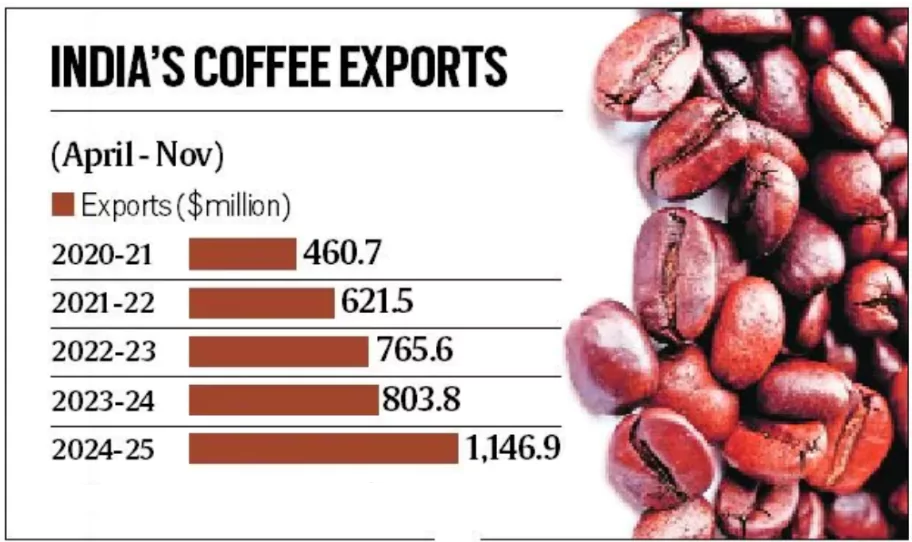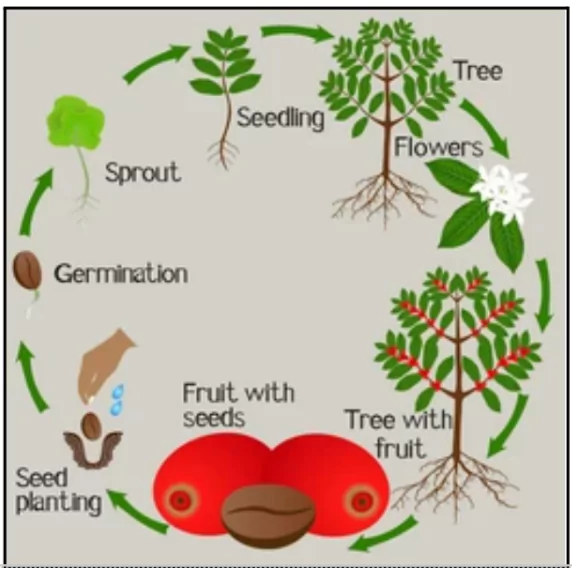Indian coffee exports crossed the $1 billion mark for the first time in FY24, showcasing the growing global recognition of Indian coffee, according to data from the Centre for Monitoring Indian Economy (CMIE).
Key Highlights on Coffee Export

- Record Exports: Indian coffee exports between April and November FY24 reached $1,146.9 million, a 29% rise from $803.8 million last year and nearly double the $460 million in FY21.
- Growth Drivers: A surge in Robusta coffee prices and stockpiling by European buyers ahead of the EU’s deforestation regulation fueled export growth.
- Price Surge: Global Robusta prices hit multi-decade highs, peaking at $4,667 per metric ton in June 2024, marking a 63% annual increase.
- Market Trends: Supply constraints in Brazil and Vietnam, caused by adverse weather, created opportunities for Indian coffee in the premium export segment.
- Key Destinations: The European Union, with Italy, Belgium, and Germany as major buyers, accounts for nearly 50% of India’s coffee exports, followed by the US, Russia, and the UAE.
Enroll now for UPSC Online Classes
Climatic Conditions Required for Coffee Production

- Coffee cultivation thrives in a hot and humid climate.
- The ideal temperature range for coffee growth is between 15°C and 28°C.
- The crop requires annual rainfall between 150 cm and 250 cm.
- Well-drained, loamy soils enriched with humus and minerals such as iron and calcium are ideal for coffee cultivation.
- Coffee is typically grown under shady trees.
- Dry weather is essential during the ripening stage of the coffee berries.
- Coffee plants are cultivated on hill slopes at elevations ranging from 600 to 1,600 meters above sea level.
History of Coffee in India
- Introduction to India: Coffee was introduced to India in 1670 when Baba Budan, an Indian pilgrim to Mecca, smuggled seven coffee beans from Yemen and planted them in the Chandragiri hills of Karnataka. At the time, it was illegal to export coffee seeds from Arabia.
- Role of the Dutch: During the 17th century, the Dutch, who occupied parts of India, contributed to the spread of coffee cultivation.
- British Era Commercialization: Coffee farming flourished commercially during the British Raj in the mid-19th century, especially in the Mysore region.
- Origin: Coffee is native to the highlands of Southern Ethiopia.
|
About Coffee Production in India
- Global Position: India ranks as the seventh-largest coffee producer globally, following Brazil (the largest producer contributing 40% of global production), Vietnam (20%), Colombia, Indonesia, Ethiopia, and Uganda.
- India is the fifth-largest coffee exporter after Brazil, Vietnam, Colombia, and Indonesia.
- Varieties Produced: India primarily grows two varieties of coffee: Arabica and Robusta.
- Arabica is cultivated at higher altitudes and is valued for its superior aroma, resulting in a higher market price.
- Robusta is known for its strength and is widely used in blends, making it the dominant variety, accounting for 72% of India’s total coffee production.
- State-Wise Production:
- Karnataka is the leading coffee-producing state in India, contributing 70% of the country’s total production.
- Kerala follows with 23%, and Tamil Nadu accounts for 5%.
- Other contributors include Odisha and the northeastern states.
Check Out UPSC NCERT Textbooks From PW Store
About Coffee Board
- Statutory Body: The Coffee Board of India was established under the Coffee Act VII of 1942.
- It operates under the administrative control of the Ministry of Commerce and Industry.
- Headquarters and Structure: The Coffee Board is headquartered in Bengaluru and consists of 33 members, including the Chairperson, who serves as the Chief Executive.
Challenges for Indian Coffee Exporter
- EU’s Deforestation Regulation (EUDR): EUDR aimed at curbing products sourced from deforested land, poses compliance challenges for Indian exporters.
- India’s agricultural exports to the EU, valued at $1.3 billion, are at risk of higher costs due to stricter compliance mechanisms under the EUDR and the Foreign Subsidies Regulation (FSR).
- Products most affected include coffee, leather, paper products, and wooden furniture.
Challenges in coffee production
- Pests and Diseases: Coffee leaf rust (la roya) and pests like the coffee berry borer affect crop yield and quality, with resistant varieties becoming susceptible over time.
- Climate Change: Rising temperatures and erratic rainfall reduce Arabica’s fertile land, increase pest activity, and disrupt harvest patterns.
- Unpredictable Weather: Sudden rains cause cherry splitting, fermentation, and inconsistent ripening, impacting coffee flavor and specialty grade status.
- Labour Shortages: Aging farmer populations and lack of pickers for manual harvesting raise costs and force automation.
- Price Fluctuations: Unstable commodity prices and high production costs create unreliable incomes, deterring investment in specialty coffee.
Enroll now for UPSC Online Classes
Conclusion
India’s coffee sector is making remarkable strides in the global market, driven by rising demand, competitive pricing, and premium quality. However, challenges from stringent EU regulations underscore the need for exporters to adapt to evolving compliance requirements to sustain this growth trajectory.
![]() 1 Jan 2025
1 Jan 2025



